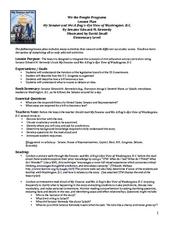Curated OER
Compare and Chart the Stories
Elementary schoolers engage in a literature study. They make comparisons of two different versions of a story using a graphic organizer. Using the text and pictures elementary schoolers investigate three elements from the story. Then,...
Curated OER
Web Designs: A Story Comes Alive
Students work cooperatively to choose a theme, write a story, and produce a web site to display this story in this middle-level instructional activity on the career of a web designer. This excellent instructional activity ends with an...
Curated OER
Periodical Cicada Survival
Young scholars explore defense mechanisms involved in predatory/prey relationships.They engage in a discussion about predatory/prey interactions. They reflect on the life cycle and behavior of the cicada.
Curated OER
Habitats
Students examine how different living things interact with their environment. As a class, they discuss the characteristics of a habitat and write the list on the board. In groups, they focus on one habitat and create a mural of the...
Curated OER
Sorting
Students examine the concepts of organization and classification. In this library skills lesson, students practice ordering and sorting skills by playing an interactive Internet game. Students then practice their classification skills in...
Curated OER
My Senator and Me: A Dog's-Eye View of Washington, D.C.
Although this legislative process lesson is designed to accompany a specific text, it is valuable independently. Young learners participate in a picture walk (worksheet included) through My Senator and Me: A Dog's-Eye View of Washington,...
iCivics
The Executive Command
Take on the role of president of the United States with this interactive online game, which will acquaint your learners with the various responsibilities of the executive branch of government. While not an in-depth or complex resource,...
Curated OER
Literary Analysis of Theme
Remember reading "The Lottery" and "The Possibility of Evil" by Shirley Jackson? Learners can experience and analyze the tension, themes, and human experience found in these pieces through reading and class discussion. They use...
BBC
Sorting and Using Materials
First and second graders see that everyday objects are made from a variety of materials. They interact with objects such as keys, plastic spoons, a wooden ruler, a towel, and a plastic bag. A discussion ensues which leads them to...
Curated OER
Zome System
Get hundreds of interactive activity plans using the Zome Modeling System. Among dozens of lessons, a first exposure to similar triangles can be very visual for the learner. Here, young geometers explore the number of different shapes...
Curated OER
Viruses and Bacteria
A series of questions about archaebacteria and eubacteria reinforce a chapter on viruses and bacteria. This worksheet is from chapter 18 of an unspecified textbook, but could work with your biology lecture as well. High schoolers...
Curated OER
Properties
In this properties activity, students classify each of the properties given as either extensive or intensive and as either physical or chemical. This activity has 1 graphic organizer and 8 fill in the blank questions.
Curated OER
Introducing Literary Elements in Fiction
Identify literary elements in fiction. In this reading comprehension lesson plan, learners read the book Pigsty and record literary elements onto a graphic organizer. They specifically discuss the main characters and events in the text.
Curated OER
Poetry Reading for ELL Beginners
Bring the imagery of the desert to your classroom with this ELL lesson plan. After reading Madeleine Dunphy’s Here in the Southwestern Desert, learners complete a graphic organizer about the features and images of the poem. The...
Curated OER
Chapter 16, Food Biotechnology
Although the points given on these slides are valid, the visual accessibility is poor. Consequently, many viewers would be distracted or entirely unable to view the presentation. The content is a review of microorganisms and their...
Curated OER
Oil Well That Ends Well
Focusing on the effect of oil spills on the environment, learners conduct experiments to explore this issue. First, they create an ocean environment using materials provided. Then, they make a simulated crude oil substance from vegetable...
Curated OER
World Flags: ESL Lesson, Beginning Level
Include this presentation in your social studies lesson about world flags. Each slide contains a vivid illustration of a flag and its country. The slides are organized in alphabetical order. Designed for an ESL class, the slides would...
Curated OER
The Human Body: Bones
Here is an interactive PowerPoint about the skeletal system. The first slide shows the entire skeleton and allows learners to try to name each major bone structure before clicking to show the answer. The following slides provide more...
Curated OER
Vocabulary Development
By utilizing a graphic organizer called a bubble map, young readers work toward developing their vocabulary. After reading a story, a word that has something to do with the story is put in the middle circle. Then, other words that have...
Polk Bros Foundation
Evaluate Decisions
When people and characters make choices, there are positive and negative consequences. Focus on a situation in a text your class is reading and analyze the characters' decisions. There is space in the graphic organizer to write about...
Wild BC
The Greenhouse Effect: The Role of CO2
Though this is meant to be second in a two-part lesson, the two are not dependent on each other. Pupils play the roles of visible light rays, light or dark surfaces, and carbon dioxide molecules. They interact and react according to...
Curated OER
Symbiotic Relationships
Seventh graders research types of symbiotic relationships on the Internet and explain what the effects would be in one of the species disappears. For this investigative lesson students use the Internet to do research then participate in...
Curated OER
My Biotic Creation
Eighth graders explore different ecosystems. In this ecosystem survival lesson conditions lesson students create their own fictional creature.
Alabama Learning Exchange
Diverse Life Forms of the Ocean
Students recognize marine organisms and differentiate between plankton and nekton. In this investigative instructional activity students create a concept map using their list of terms and study marine life forms.

























